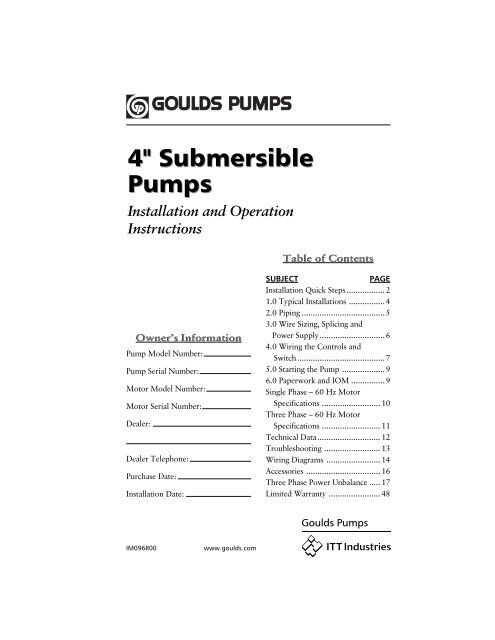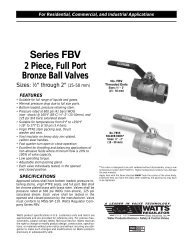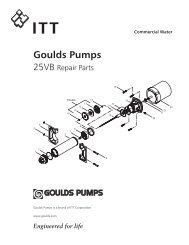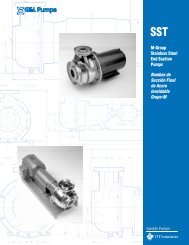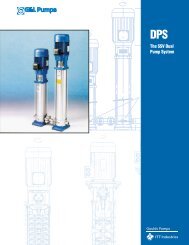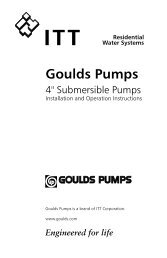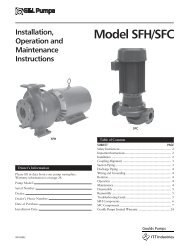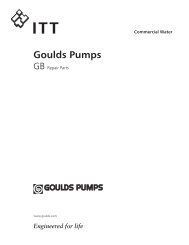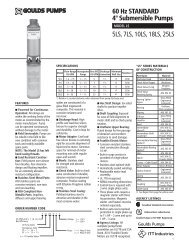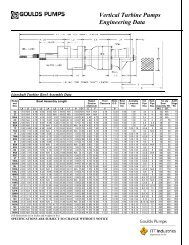4" Submersible Pumps
4" Submersible Pumps
4" Submersible Pumps
Create successful ePaper yourself
Turn your PDF publications into a flip-book with our unique Google optimized e-Paper software.
4" <strong>Submersible</strong><br />
<strong>Pumps</strong><br />
Installation and Operation<br />
Instructions<br />
Owner’s Information<br />
Pump Model Number:<br />
Pump Serial Number:<br />
Motor Model Number:<br />
Motor Serial Number:<br />
Dealer:<br />
Dealer Telephone:<br />
Purchase Date:<br />
Installation Date:<br />
IM096R00 www.goulds.com<br />
Table of Contents<br />
SUBJECT PAGE<br />
Installation Quick Steps .................2<br />
1.0 Typical Installations ................4<br />
2.0 Piping .....................................5<br />
3.0 Wire Sizing, Splicing and<br />
Power Supply .............................6<br />
4.0 Wiring the Controls and<br />
Switch .......................................7<br />
5.0 Starting the Pump ...................9<br />
6.0 Paperwork and IOM ...............9<br />
Single Phase – 60 Hz Motor<br />
Specifications .......................... 10<br />
Three Phase – 60 Hz Motor<br />
Specifications .......................... 11<br />
Technical Data............................ 12<br />
Troubleshooting ......................... 13<br />
Wiring Diagrams ........................ 14<br />
Accessories ................................. 16<br />
Three Phase Power Unbalance ..... 17<br />
Limited Warranty ....................... 48
INSTALLATION<br />
INSTALLATION<br />
QUICK QUICK STEPS! STEPS!<br />
1The well should be clean and<br />
disinfected before the<br />
pump is installed. You should<br />
always develop the well before<br />
pump installation.<br />
2Write the pump model<br />
number, pump serial number,<br />
and motor serial number in<br />
the space provided in this<br />
Instruction Manual (IOM).<br />
Leave the completed IOM<br />
attached to the tank or control<br />
box in a dry area or give it to the<br />
owner. We suggest you attach<br />
your business card to promote<br />
referral business.<br />
3<br />
Inspect all components for<br />
shipping damage and insure<br />
that you have all the<br />
components that are required:<br />
Pump with Motor, Motor<br />
Control Box (1∅ / 3-wire) or<br />
Starter w/Overloads (3∅),<br />
Hydro-Pro Tank, Pressure<br />
Switch, Copper Wire, Pressure<br />
Relief Valve (if required),<br />
Torque Arrestor (if required),<br />
Pipe, and Fittings. See 1.0<br />
4Verify that motor voltage and<br />
power supply voltage match.<br />
See 4.2<br />
NOTE: Do not power the unit or<br />
run the pump until all<br />
electrical and plumbing<br />
connections are completed and<br />
the pump is filled with water.<br />
Under no circumstance should<br />
the pump be run dry to test it.<br />
2<br />
Doing so will void the warranty<br />
and damage the impellers! We<br />
suggest you check the rotation on<br />
a three phase motor before<br />
assembling it to the water end<br />
(pump). All 4" motors should<br />
rotate counterclockwise when<br />
viewed from the shaft end. See<br />
4.3 C and 4.4<br />
5Select a well-ventilated,<br />
shaded location in which to<br />
vertically mount the motor<br />
control box. See 4.1<br />
DANGER<br />
Hazardous<br />
voltage<br />
6Connect the pump motor<br />
leads (wires) to the drop<br />
cable using a heat shrink kit<br />
or waterproof electrical tape.<br />
Match the drop cable wire colors<br />
to the pump motor leads or<br />
identify the leads to insure<br />
correct connections at the threewire<br />
motor control box where<br />
used. See 3.1 A&B and 4.3<br />
7If using unthreaded discharge<br />
pipe install a stainless steel<br />
adapter fitting into the pump<br />
discharge head. Consult your<br />
pump supplier for other available<br />
adapter materials. Connect the<br />
discharge pipe to the pump. Do<br />
not use galvanized connections<br />
on stainless steel discharge heads<br />
as galvanic corrosion may occur.<br />
See 2.4<br />
8You can now lower the pump<br />
into the well. Set the pump at<br />
least 10' off the bottom.<br />
Protect the wires from chafing on<br />
the well casing. Never lower the<br />
pump by the wires. See 2.5
CAUTION<br />
Hazardous<br />
Pressure<br />
9Connect the discharge pipe<br />
to the pressure tank and the<br />
house plumbing. Install the<br />
pressure switch at the tank cross<br />
tee. See 2.2<br />
CAUTION<br />
Hazardous<br />
Pressure<br />
what system<br />
pressure you want to<br />
10Decide<br />
use. Adjust the pressure<br />
switch to the desired range.<br />
Typically a 20 pound differential<br />
is used, eg.: 30-50 or 40-60 psi.<br />
Furnas switches have adjustment<br />
instructions on the inside of the<br />
cover.<br />
CAUTION<br />
Hazardous<br />
Pressure<br />
the pressure tank<br />
pre-charge 2 psi lower<br />
11Set<br />
than the pump cut-in<br />
pressure. Check tank pre-charge<br />
only when tank is completely<br />
empty. See 2.3<br />
CAUTION<br />
Hazardous<br />
Pressure<br />
12<br />
Install a pressure relief<br />
valve in any system<br />
capable of over 100 psi<br />
or 230' TDH. Install and set per<br />
relief valve manufacturers<br />
instructions. See 2.2<br />
DANGER<br />
Hazardous<br />
voltage<br />
13<br />
Connect the motor leads<br />
to the control box<br />
(3-wire), pressure<br />
switch (2-wire), or starter on<br />
3 phase systems. See 4.3<br />
DANGER<br />
Hazardous<br />
voltage<br />
DANGER<br />
Hazardous<br />
voltage<br />
14<br />
Connect the leads<br />
between the control<br />
box or starter and the<br />
pressure switch. See 4.3<br />
all piping<br />
connections before<br />
15Check<br />
starting pump.<br />
See 2.0 and 5.0<br />
CAUTION<br />
Hazardous<br />
Pressure<br />
flow between<br />
pump and tank if well<br />
16Restrict<br />
has a high static level or<br />
there is a long discharge pipe<br />
between well and tank. A<br />
partially closed ball or globe<br />
valve works well for throttling.<br />
See 5.1<br />
a faucet in the<br />
discharge piping. This<br />
17Open<br />
will allow air to escape<br />
the system and water to flow<br />
without filling the tank with<br />
dirty water. See 5.3<br />
DANGER<br />
Hazardous<br />
voltage<br />
breaker ON to<br />
power system. Pump<br />
18Turn<br />
should run. Allow water<br />
to flow until well clears. You can<br />
then close the faucet and allow<br />
the tank to fill and pressure to<br />
build. Switch should go ON and<br />
OFF without any chatter. See 5.3<br />
a few cycles to<br />
check pump and switch<br />
19Run<br />
operation. See 5.3<br />
DANGER<br />
Hazardous<br />
voltage<br />
20 Check<br />
amps and insure<br />
they are within<br />
nameplate amp range<br />
from motor data sheet or motor<br />
nameplate. Amps should be<br />
between Rated Input and Service<br />
Factor Amps. Enter the amp<br />
reading in this manual along<br />
with the model number.<br />
See Motor Specifications<br />
3
HYDRO-PRO TANK INSTALLATION<br />
NOTICE: TANK PRE-CHARGE PRESSURE CHANGES MUST BE<br />
MADE USING THE AIR VALVE ON TOP OF THE TANK.<br />
Protected Power Supply<br />
To House Piping<br />
Disconnect Switch<br />
Figure 1<br />
GALVANIZED TANK INSTALLATION<br />
Disconnect Switch<br />
Protected Power Supply<br />
4<br />
1.0 TYPICAL INSTALLATIONS<br />
Control Box Pressure<br />
Gauge To House<br />
Piping<br />
Pitless Adapter<br />
Frost Level<br />
Drain and Y Fitting AV11<br />
Figure 2<br />
Shut-off Valve<br />
Union<br />
Drain Tap<br />
Shut-off Valve<br />
Union<br />
Pressure Relief Valve AV12 _ _ _<br />
Drain Tap<br />
Tank Tee<br />
Pressure Switch AS4FX or AS4<br />
Pressure Relief Valve AV12_ _ _<br />
Air Escape Control AA4<br />
Pressure Switch AS4FX or AS4<br />
Line Check Valve with Snifter AV9<br />
Union<br />
Approximate Drain Fitting Setting<br />
Distance Drain and “Y”<br />
Tank Capacity Fitting Below the Line Check<br />
42 gallon (159 L) 7 feet (2.1m)<br />
82 gallon (310 L) 10 feet (3m)<br />
120 gallon (454 L) 15 feet (4.6m)<br />
220 gallon (833 L) 15 feet (4.6m)<br />
315 gallon (1192 L) 20 feet (6.1m)<br />
525 gallon (1981 L) 20 feet (6.1m)
2.0 PIPING<br />
Notice: All 4" Goulds <strong>Pumps</strong><br />
submersibles have left-hand<br />
discharge head threads, hold the<br />
pump only at the “discharge head”<br />
with a wrench when installing<br />
fittings or threaded pipe.<br />
CAUTION<br />
Hazardous pressure can<br />
cause personal injury or<br />
property damage.<br />
2.1 General<br />
The pump discharge<br />
piping should be sized<br />
for efficient pump<br />
operation. We suggest<br />
using the Friction Loss<br />
Tables to calculate Total Dynamic<br />
Head using different pipe sizes. As<br />
a rule of thumb use 1" for up to<br />
10 gpm, 1 1 ⁄4" for up to 30 gpm, 1 1 ⁄2"<br />
for up to 45 gpm, and 2" for up to<br />
80 gpm. In the case of long pipe<br />
runs it is best to increase pipe size.<br />
Some pumps are capable of very<br />
high discharge pressures, please<br />
select pipe accordingly. Since<br />
Goulds <strong>Pumps</strong> does not sell pipe,<br />
we suggest you consult with your<br />
pipe supplier to determine the best<br />
type of pipe for each installation.<br />
CAUTION<br />
Hazardous pressure can<br />
cause personal injury or<br />
property damage.<br />
2.2Pressure Tank,<br />
Pressure Switch<br />
and Pressure<br />
Relief Valve<br />
Select an area in which<br />
the ambient temperature<br />
is always above 34° F (1° C) in<br />
which to install the tank, pressure<br />
switch, and pressure relief valve.<br />
The tank should be located in an<br />
area where a leak will not damage<br />
property.<br />
The pressure switch should be<br />
located at the tank cross tee and<br />
never more than 4' from the tank.<br />
Locating the switch more than<br />
4' from the tank will cause<br />
switch chatter.<br />
There should be no valves, filters,<br />
or high loss fittings between the<br />
switch and the tank(s) as switch<br />
chatter may result. As an example,<br />
a 1 1 ⁄4" spring check valve has<br />
friction loss equal to 12' of pipe,<br />
placing the valve between the<br />
pressure switch and the pressure<br />
tank is the same as moving the<br />
pressure switch 12' away from the<br />
tank. It will create switch chatter.<br />
On multiple tank installations the<br />
switch should be as close to the<br />
center of the tanks as possible.<br />
Multiple tank installations should<br />
have a manifold pipe at least 1 1 ⁄2<br />
times the size of the supply pipe<br />
from the pump. This is to reduce<br />
the Friction Head in the manifold<br />
and to reduce the possibility of<br />
switch chatter.<br />
The cut-in setting on a 30 - 50<br />
pressure switch is 30 psi. Cut-in is<br />
the lower of the pressure settings.<br />
Pressure relief valves are required<br />
on any system that is capable of<br />
producing 100 psi or 230' TDH. If<br />
in an area where a water leak or<br />
blow-off may damage property<br />
connect a drain line to the pressure<br />
relief valve. Run it to a suitable<br />
drain or an area where the water<br />
will not damage property.<br />
2.3 Adjusting Tank<br />
Pre-Charge<br />
Insure that the tank is empty of<br />
water. Use a high quality pressure<br />
gauge to check the tank pre-charge<br />
pressure. The pressure should be<br />
2 psi below the pump cut-in<br />
pressure. As an example, a<br />
30-50 psi system would use<br />
a tank pre-charge of 28 psi.<br />
5
2.4 Discharge Pipe and<br />
Check Valve<br />
Note: The discharge head is<br />
threaded into the casing with lefthand<br />
threads. Please hold the pump<br />
only at the discharge head with a<br />
pipe wrench when installing<br />
fittings. Failure to hold the<br />
discharge head will loosen it and<br />
pump damage will result on<br />
start-up.<br />
If your pipe requires an adapter we<br />
strongly recommend using stainless<br />
steel. Galvanized fittings or pipe<br />
should never be connected directly<br />
to a stainless steel discharge head as<br />
galvanic corrosion may occur.<br />
Plastic or brass pumps can use any<br />
material for this connection. Barb<br />
type connectors should always be<br />
double clamped.<br />
The pump discharge head has a<br />
loop for attaching a safety cable.<br />
The use of a safety cable is at the<br />
discretion of the installer.<br />
2.5 Installing Pump in Well<br />
If you are using a torque arrestor,<br />
install it per the manufacturer’s<br />
installation instructions. Goulds<br />
<strong>Pumps</strong> does not sell torque<br />
arrestors and has no installation<br />
instructions, please consult the<br />
seller for information.<br />
Connect the discharge pipe to the<br />
discharge head or adapter you<br />
previously installed. Barb style<br />
connectors should always be double<br />
clamped. You can install the pump<br />
into the well using a pitless adapter<br />
or similar device at the wellhead.<br />
Consult the fitting manufacturer or<br />
pitless supplier for specific<br />
installation instructions.<br />
Using waterproof electrical tape<br />
fasten the wires to the drop pipe at<br />
6<br />
10' intervals. Make sure that the<br />
tape does not loosen as it will block<br />
the pump suction if it falls down<br />
the well. Pump suppliers also sell<br />
clip-on style wire connectors that<br />
attach to the drop pipe.<br />
2.6 Special Piping For<br />
Galvanized Tank<br />
Systems<br />
When using a galvanized tank you<br />
should install an AV11 Drain &<br />
Y fitting in the well and an AV9<br />
check valve with snifter valve at the<br />
tank. This will add air to the tank<br />
on each pump start and prevent<br />
water logging the tank. Use an AA4<br />
Air Escape on the tank to allow<br />
excess air to escape. The distance<br />
between the AV11 and AV9<br />
determines the amount of air<br />
introduced on each cycle. See the<br />
table for recommended settings.<br />
See Fig. 2 in Sec 1.0.<br />
Gaseous wells should use<br />
galvanized tanks with AA4 air<br />
escapes to vent off excess air and<br />
prevent “spurting” at the faucets.<br />
Methane and other explosive or<br />
dangerous gases require special<br />
water treatment for safe removal.<br />
Consult a water treatment specialist<br />
to address these issues.<br />
Installations with top feeding wells<br />
should use flow sleeves on the<br />
pump.<br />
DANGER<br />
Hazardous voltage<br />
can shock, burn or<br />
cause death.<br />
3.0 WIRE<br />
SIZING,<br />
SPLICING and<br />
POWER SUPPLY<br />
Always follow the National Electric<br />
Code (N.E.C.), Canadian Electrical<br />
Code, and any state, provincial, or<br />
local codes.
We suggest using only copper wire.<br />
Size wire from the charts found in<br />
your Goulds <strong>Pumps</strong> catalog - Jet &<br />
Sub Accessories - Electrical Section,<br />
in the Franklin Electric AIM<br />
manual, or an N.E.C.( National<br />
Electric Code) code book. If<br />
discrepancies exist the N.E.C. book<br />
takes precedence over a<br />
manufacturer’s recommendations.<br />
3.1 Splicing Wire to<br />
Motor Leads<br />
When the drop cable must be<br />
spliced or connected to the motor<br />
lead it is necessary that the splice be<br />
watertight. The splice can be done<br />
with heat shrink kits or waterproof<br />
tape.<br />
A. Heat Shrink Splice Instructions<br />
To use a typical heat shrink kit:<br />
strip 1 ⁄2" from the motor wires and<br />
drop cable wires, it is best to<br />
stagger the splices. Place the heat<br />
shrink tubes on the wires. Place the<br />
crimps on the wires and crimp the<br />
ends. Slide the heat shrink tubes<br />
over the crimps and heat from the<br />
center outward. The sealant and<br />
adhesive will ooze out the ends<br />
when the tube shrinks. The tube,<br />
crimps, sealant, and adhesive create<br />
a very strong, watertight seal.<br />
B. Taped Splice Instructions<br />
A) Strip individual conductor of<br />
insulation only as far as<br />
necessary to provide room for a<br />
stake type connector. Tubular<br />
connectors of the staked type are<br />
preferred. If connector O.D. is<br />
not as large as cable insulation,<br />
build-up with rubber electrical<br />
tape.<br />
B) Tape individual joints with<br />
rubber electrical tape, using two<br />
layers; the first extending two<br />
inches beyond each end of the<br />
conductor insulation end, the<br />
second layer two inches beyond<br />
the ends of the first layer. Wrap<br />
tightly, eliminating air spaces as<br />
much as possible.<br />
C) Tape over the rubber electrical<br />
tape with #33 Scotch electrical<br />
tape, or equivalent, using two<br />
layers as in step "B" and making<br />
each layer overlap the end of the<br />
preceding layer by at least two<br />
inches.<br />
In the case of a cable with three<br />
conductors encased in a single<br />
outer sheath, tape individual<br />
conductors as described, staggering<br />
joints.<br />
Total thickness of tape should be<br />
no less than the thickness of the<br />
conductor insulation.<br />
DANGER<br />
Hazardous voltage<br />
can shock, burn or<br />
cause death.<br />
4.0 4.0 WIRING WIRING<br />
THE THE<br />
CONTROLS CONTROLS and and<br />
SWITCH SWITCH<br />
4.1 Mounting the Motor<br />
Control Box<br />
Franklin and Goulds <strong>Pumps</strong> single<br />
phase 3-wire control boxes meet<br />
U.L. requirements for Type 3R<br />
enclosures. They are suitable for<br />
vertical mounting in indoor and<br />
outdoor locations. They will<br />
operate at temperatures between<br />
14°F (-10°C) and 122°F (50°C).<br />
Select a shaded, dry place to mount<br />
the box. Insure that there is enough<br />
clearance for the cover to be<br />
removed.<br />
7
4.2 Verify Voltage and Turn<br />
Supply Power Off<br />
Insure that your motor voltage and<br />
power supply voltage are the same.<br />
Place the circuit breaker or<br />
disconnect switch in the OFF<br />
position to prevent accidentally<br />
starting the pump before you are<br />
ready.<br />
Three-phase starter coils are very<br />
voltage sensitive; we suggest you<br />
always verify actual supply voltage<br />
with a voltmeter.<br />
High or low voltage, greater than<br />
± 10%, will damage motors and<br />
controls and is not covered under<br />
warranty.<br />
4.3 Connecting Motor Leads<br />
to Motor Control Box,<br />
Pressure Switch, or<br />
Starter<br />
8<br />
DANGER<br />
Hazardous voltage<br />
can shock, burn or<br />
cause death.<br />
Caution Do not power the<br />
unit or run the pump until<br />
all electrical and plumbing<br />
connections are<br />
completed. Verify that the<br />
disconnect or breaker is<br />
OFF before connecting the pressure<br />
switch line leads to the power<br />
supply. Follow all local and<br />
national codes. Use a disconnect<br />
where required by code.<br />
A. Three-Wire Single Phase Motor<br />
Connect the color coded motor<br />
leads to the motor control box<br />
terminals - Y (yellow), R (red), and<br />
B (black); and the Green or bare<br />
wire to the green ground screw.<br />
Connect wires between the Load<br />
terminals on the pressure switch<br />
and control box terminals L1 and<br />
L2. Run a ground wire between the<br />
switch ground and the control box<br />
ground. See Figure 4 or 5<br />
B. Two-Wire Single Phase Motor<br />
Connect the black motor leads to<br />
the Load terminals on the pressure<br />
switch and the green or bare<br />
ground wire to the green ground<br />
screw. See Figure 3<br />
C. Three phase motors<br />
Connect the motor leads to T1, T2,<br />
and T3 on the 3 phase starter.<br />
Connect the ground wire to the<br />
ground screw in the starter box.<br />
Follow starter manufacturers<br />
instructions for connecting pressure<br />
switch or see Figure 6.<br />
DANGER<br />
Hazardous voltage<br />
can shock, burn or<br />
cause death.<br />
4.4 Connect To<br />
Power Supply<br />
Complete the wiring by<br />
making the connection<br />
from the single phase<br />
pressure switch Line terminals to<br />
the circuit breaker panel or<br />
disconnect where used.<br />
On three phase installations make<br />
the connections between L1, L2,<br />
L3, and ground on the starter to<br />
the disconnect or circuit breaker.<br />
Three phase submersible motors<br />
require Class 10 Quick-Trip<br />
overloads. Our ESP100 starters use<br />
adjustable overloads which you<br />
must adjust during installation.<br />
Goulds <strong>Pumps</strong> sells Furnas starters<br />
which use “K” heaters for Class 10<br />
ambient compensated overload<br />
protection. Use of Class 20<br />
overloads voids the motor<br />
warranty.<br />
Three phase installations must be<br />
checked for motor rotation and<br />
phase unbalance. To reverse motor<br />
rotation switch (reverse) any two
leads. See the instructions for<br />
checking three phase unbalance in<br />
the Technical Section of this<br />
manual. Failure to check phase<br />
unbalance can cause premature<br />
motor failure and nuisance overload<br />
tripping. If using a generator,<br />
see Technical Data for generators.<br />
5.0 STARTING<br />
THE PUMP<br />
CAUTION<br />
Hazardous pressure can<br />
cause personal injury or<br />
property damage.<br />
5.1 Throttling<br />
Discharge On<br />
Start-Up<br />
If the pump will be<br />
operated to clear the well<br />
and/or operate with no pressure or<br />
very little head we strongly suggest<br />
you throttle the discharge. Install a<br />
ball valve in the discharge line.<br />
Open the valve to approximately<br />
1 ⁄3 open on system start-up. After<br />
starting, use the valve to adjust the<br />
flow. This will prevent upthrust<br />
damage to the pump and motor<br />
bearings. It will also keep the pump<br />
running in its recommended<br />
operating range. Starting or running<br />
a pump with little or no head is a<br />
major cause of premature failure.<br />
CAUTION<br />
Hazardous pressure can<br />
cause personal injury or<br />
property damage.<br />
5.2 Throttling A<br />
High Static<br />
Level Well To<br />
Prevent Upthrust<br />
Any well with a high<br />
static water level may allow the<br />
pump to operate off the curve to<br />
the right or outside the<br />
“Recommended Range” shown on<br />
the pump curve. We recommend<br />
using a “Dole” flow restrictor or<br />
throttling with a ball valve to<br />
prevent upthrust damage to the<br />
pump and motor. The maximum<br />
flow must be restricted to be within<br />
the pumps recommended operating<br />
range. If you use a ball valve, set it,<br />
remove the handle, tape the handle<br />
to the pipe, and tag the valve with a<br />
note saying, “Do not open this<br />
valve or pump may be damaged”.<br />
The easiest way to “set” the flow is<br />
to fill a 5 gallon bucket and time<br />
how long it takes to produce 5<br />
gallons. Calculate the flow in gpm<br />
based on this value. As the water<br />
level drops in the well the flow will<br />
be reduced due to increased head<br />
and the valve will not interfere with<br />
performance.<br />
5.3 Start the Pump<br />
Partially open a valve (faucet) in the<br />
system and turn the breaker to the<br />
ON position.<br />
Check all fittings for leaks.<br />
Close the valve when the water<br />
clears and allow the pressure to<br />
build. If properly adjusted the<br />
switch should turn the pump off at<br />
the preset pressure. Open a few<br />
faucets and allow the pump to run<br />
through a few cycles. Check switch<br />
operation and verify that pressure<br />
settings are correct.<br />
Recheck all fittings for leaks.<br />
6.0 PAPERWORK<br />
and IOM<br />
Please give the owner all warranty<br />
and IOM paperwork. It is wise to<br />
include your business card with the<br />
Goulds <strong>Pumps</strong> supplied paperwork.<br />
A sticker with your name and<br />
phone number on the tank or<br />
control box is a great sales tool for<br />
future business!<br />
Congratulations on completing a<br />
professional installation of a Goulds<br />
Pump.<br />
9
SINGLE PHASE – 60 HZ MOTOR SPECIFICATIONS<br />
Type, Goulds Franklin HP, Volts, Amps, S.F<br />
Tipo, # # CV, Voltios, Hz S.F. Amperios, Amps Ohms Std. Delay Control<br />
Type Goulds n<br />
10<br />
o Franklin no hp V FS A A avec FS M=Main S=Start Cir. Br. Fuse Box<br />
S04932 2445040 1<br />
⁄2 115 60 1.60 10.0 12.0 1.0 – 1.3 30 15 N/R, NR<br />
S04942 2445050 1<br />
⁄2 230 60 1.60 5.0 6.0 4.2 – 5.2 15 7 N/R, NR<br />
S05942 2445070 3<br />
⁄4 230 60 1.50 7.2 8.4 3.0 – 3.6 25 10 N/R, NR<br />
S06942 2445081 1 230 60 1.40 8.2 9.8 2.2 – 2.7 25 12 N/R, NR<br />
S07942 2445091 11 ⁄2 230 60 1.30 10.6 13.1 1.5 – 1.9 35 15 N/R, NR<br />
S04930 2145044 1<br />
⁄2 115 60 1.60 Y=10.0 Y=12.0 M = 1.0 – 1.3 30 15 00043<br />
B=10.0 B=12.0 S = 4.1 – 5.1<br />
R=0.0 R=0.0<br />
S04940 2145054 1<br />
⁄2 230 60 1.60 Y=5.0 Y=6.0 M = 4.2 – 5.2 15 7 00044<br />
B=5.0 B=6.0 S = 16.7 – 20.5<br />
R=0.0 R=0.0<br />
S05940 2145074 3<br />
⁄4 230 60 1.50 Y=5.0 Y=6.0 M = 3.0 – 3.6 25 10 00054<br />
B=5.0 B=6.0 S = 11.0 – 13.4<br />
R=0.0 R=0.0<br />
S06940 2145081 1 230 60 1.40 Y=8.2 Y=9.8 M = 2.2 – 2.7 25 12 00064<br />
B=8.2 B=9.8 S = 10.1 – 12.3<br />
R=0.0 R=0.0<br />
S07940 2243001 11 SINGLE PHASE – 60 HZ MOTOR SPECIFICATIONS<br />
1<br />
5 6 7 8<br />
⁄2 230 60 1.30 Y=10.0 Y=11.6 M = 1.5 – 2.3 30 15 00074<br />
B=9.9 B=11.0 S = 6.2 – 12.0<br />
R=1.3 R=1.3<br />
S08940 2243011 2 230 60 1.25 Y=10.0 Y=13.2 M = 1.6 – 2.3 30 15 00084<br />
B=9.9 B=11.9 S = 5.2 – 7.15<br />
R=2.6 R=2.6<br />
S09940 2243027 3 230 60 1.15 Y=14.0 Y=17.0 M = 0.9 – 1.5 45 20 00094<br />
B=12.2 B=14.5 S = 3.0 – 4.9<br />
R=4.7 R=4.5<br />
S10940 2243037 5 230 60 1.15 Y=23.0 Y=27.5 M = 0.68 – 1.0 70 30 00104<br />
B=19.1 B=23.2 S = 2.1 – 2.8<br />
R=8.0 R=7.8<br />
9 M = Main Winding – Black to Yellow, S = Start Winding – Red to Yellow<br />
10 Y = Yellow lead – line amps, B = Black lead – main winding amps, R = Red lead, start or auxiliary winding amps<br />
FS = facteur de surcharge ; NR = non requise.<br />
6. Cortacircuitos estándar<br />
1. ESPECIFICACIONES DE MOTOR DE 60 HZ, MONOFÁSICO 6. Disjoncteur standard<br />
1. CARACTÉRISTIQUES DES MOTEURS MONOPHASÉS, 60 Hz 7. Fusible de retardo<br />
2. 4" de tres alambres con capacitor de funcionamiento<br />
2. 4 po, 3 fils et condensateur de marche<br />
3. 4" de tres alambres<br />
3. 4 po, 3 fils<br />
4. 4" de dos alambres<br />
4. 4 po, 2 fils<br />
5. L1-L2 Resistencia – M=Principal, S=Arranque<br />
5. Voir le renvoi 9. Le 10 est en p. 11.<br />
7. Fusible à action retardée<br />
8. Caja de control<br />
8. Boîte de commande<br />
9. M=Devanado principal – Negro a amarillo;<br />
S=Devanado de arranque – Rojo a Amarillo<br />
9. M = enroulement principal – entre le fil noir et le jaune ;<br />
S = enroulement de démarrage – entre le fil rouge et le jaune.<br />
2 4" 3W 3 4" 2W 4<br />
4" 3W with RunCap
THREE PHASE – 60 HZ MOTOR SPECIFICATIONS<br />
Type, Goulds Franklin HP, Volts, Amps, S.F Locked KVA FURNAS Class 16<br />
Tipo, # # CV Voltios Hz S.F. Amperios, Amps Ohms Rotor Code Std. Delay Starter Htrs.<br />
Type Goulds n<br />
11<br />
o Franklin no hp V FS A A avec FS Amps Cir. Br. Fuse Size<br />
S04978 234501 1 ⁄2 200 60 1.6 2.8 3.4 6.64 – 7.3 17.3 N 10 5 16AD K29<br />
S04970 234511 1 ⁄2 230 60 1.6 2.4 2.9 9.5 – 10.4 15.0 N 8 4 16AG K28<br />
S04975 234521 1 ⁄2 460 60 1.6 1.2 1.5 38.4 – 41.6 7.5 N 4 2 16AH K21<br />
S05978 234502 3 ⁄4 200 60 1.5 3.6 4.4 4.66 – 5.12 24.6 N 12 6 16AD K34<br />
S05970 234512 3 ⁄4 230 60 1.5 3.1 3.8 7.24 – 7.84 21.4 N 11 5 16AG K32<br />
S05975 234522 3 ⁄4 460 60 1.5 1.6 1.9 27.8 – 30.2 10.7 N 5 3 16AH K23<br />
S06978 234503 1 200 60 1.4 4.5 5.4 4.1 – 4.5 31.0 M 15 6 16AD K37<br />
S06970 234513 1 230 60 1.4 3.9 4.7 5.2 – 5.6 27.0 M 12 6 16AG K34<br />
S06975 234523 1 460 60 1.4 2.0 2.4 21.2 – 23.0 13.5 M 6 3 16AH K26<br />
S07978 234504 11 ⁄2 200 60 1.3 5.8 6.8 2.5 – 3.0 38.1 K 20 8 16AD K42<br />
S07970 234514 11 ⁄2 230 60 1.3 5.0 5.9 3.2 – 4.0 33.1 K 15 7 16AG K39<br />
S07975 234524 11 ⁄2 460 60 1.3 2.5 3.1 13.0 – 16.0 16.6 K 8 4 16AH K29<br />
S07979 234534 11 ⁄2 575 60 1.3 2.0 2.4 20.3 – 25.0 13.2 K 6 3 16AE K26<br />
S08978 234305 2 200 60 1.25 7.7 9.3 1.9 – 2.4 53.6 L 25 10 16AD K50<br />
S08970 234315 2 230 60 1.25 6.7 8.1 2.4 – 3.0 46.6 L 20 10 16AG K43<br />
S08975 234325 2 460 60 1.25 3.4 4.1 9.7 – 12.0 23.3 L 15 5 16AH K33<br />
S08979 234335 2 575 60 1.25 2.7 3.2 15.1 – 18.7 18.6 L 15 4 16AE K29<br />
S09978 234306 3 200 60 1.15 10.9 12.5 1.3 – 1.7 71 K 35 15 16AD K55<br />
S09970 234316 3 230 60 1.15 9.5 10.9 1.8 – 2.2 62 K 30 12 16AG K52<br />
S09975 234326 3 460 60 1.15 4.8 5.5 7.0 – 8.7 31 K 15 6 16AH K37<br />
S09979 234336 3 575 60 1.15 3.8 4.4 10.9 – 13.6 25 K 12 5 16AE K34<br />
S10978 234307 5 200 60 1.15 18.3 20.5 .70 – .94 122 K 50 25 16AD K62<br />
S10970 234317 5 230 60 1.15 15.9 17.8 .93 – 1.2 106 K 45 20 16AG K61<br />
S10975 234327 5 460 60 1.15 8.0 8.9 3.6 – 4.4 53 K 25 10 16AH K49<br />
S10979 234337 5 575 60 1.15 6.4 7.1 5.6 – 6.9 43 K 20 8 16AE K42<br />
S119784 234308 71 ⁄2 200 60 1.15 26.5 30.5 .46 – .57 188 K 80 35 16CD K70<br />
S119704 234318 71 ⁄2 230 60 1.15 23.0 26.4 .61 – .75 164 K 70 30 16BG K67<br />
S119754 234328 71 11<br />
13<br />
12<br />
6 7<br />
14 15 16<br />
⁄2 460 60 1.15 11.5 13.2 2.4 – 3.4 82 K 35 15 16AH K55<br />
S129724 234339 10 460 60 1.15 13.6 15.0 2.8 – 3.5 93 K 40 20 16AH K61<br />
10. Y=Conductor amarillo - amperios de línea. B=Conductor<br />
12. Ohmios 13. Rotor frenado amperios<br />
negro - amperios del devanado principal. R=Conductor 12. Ω 13. A avec rotor bloqué<br />
rojo - amperios del devanado de arranque o auxiliar.<br />
10. Y=fil jaune ; B=fil noir – enroulement principal ;<br />
R=fil rouge – enroulement de démarrage ou auxiliaire.<br />
11.ESPECIFICACIONES DE MOTOR DE 60 HZ,<br />
TRIFÁSICO<br />
11.CARACTÉRISTIQUES DES MOTEURS TRIPHASÉS,<br />
60 Hz<br />
14. KVA Código 15. FURNAS Class 16 Arrancador<br />
14. Code kV . THREE PHASE – 60 HZ MOTOR SPECIFICATIONS<br />
A 15. Démarreur Furnas, classe 16<br />
16. FURNAS Class 16 Calentador<br />
16. Dispositif de protection contre la surcharge Furnas,<br />
classe 16<br />
FS = facteur de surcharge<br />
4" 3450 RPM, 4 po, 3 450 r/min
Technical Data<br />
MOTOR INSULATION RESISTANCE READINGS<br />
Normal Ohm/Megohm readings, ALL motors, between all leads and ground<br />
To perform insulation resistance test, open breaker and<br />
CAUTION disconnect all leads from QD control box or pressure switch.<br />
Connect one ohmmeter lead to any motor lead and one to metal drop pipe<br />
or a good ground. R x 100K Scale<br />
Condition of Motor and Leads OHM Value Megohm Value<br />
New motor, without power cable 20,000,000 (or more) 20.0<br />
Used motor, which can be reinstalled in well 10,000,000 (or more) 10.0<br />
Motor in well – Readings are power cable plus motor<br />
New motor 2,000,000 (or more) 2.0<br />
Motor in reasonably good condition<br />
Motor which may be damaged or have<br />
500,000 to 2,000,000 0.5 – 2.0<br />
damaged power cable<br />
Do not pull motor for these reasons<br />
Motor definitely damaged or with<br />
20,000 to 500,000 0.02 – 0.5<br />
damaged power cable<br />
Pull motor and repair<br />
10,000 to 20,000 0.01 – 0.02<br />
Failed motor or power cable<br />
Pull motor and repair<br />
Less than 10,000 0 – 0.01<br />
Generator Operation<br />
• For externally regulated generator kilovolt amperes (KVA) ratings see<br />
Table 1. Electrical voltage, frequency, phase and ampacity, MUST match<br />
that shown on the motor nameplate, or pump control box.<br />
DANGER<br />
Hazardous voltage<br />
can shock, burn or<br />
cause death.<br />
FAILURE TO USE A MANUAL OR AUTOMATIC<br />
TRANSFER SWITCH WHEN GENERATOR IS USED AS<br />
STANDBY OR BACKUP CAN CAUSE SHOCK, BURNS OR<br />
DEATH.<br />
Min.<br />
Generator<br />
Rating 1<br />
⁄3<br />
Pump Motor Horsepower ➀<br />
1 3 1<br />
⁄2 ⁄4 1 1 ⁄2 2 3 5<br />
KVA 1.9 2.5 3.8 5.0 6.3 9.4 12.5 18.8<br />
KW 1.5 2.0 3.0 4.0 5.0 7.5 10.0 15.0<br />
➀ NOTE: For two-wire motors, minimum generator ratings 50% higher<br />
than shown are necessary.<br />
NOTICE: FOLLOW THE GENERATOR MANUFACTURER’S<br />
INSTRUCTIONS CAREFULLY.<br />
Courtesy of Franklin Electric Company<br />
12
Troubleshooting<br />
DANGER<br />
Hazardous voltage<br />
can shock, burn or<br />
cause death.<br />
DISCONNECT AND LOCKOUT ELECTRICAL POWER<br />
BEFORE ATTEMPTING ANY SERVICE. FAILURE TO DO SO<br />
CAN CAUSE SHOCK, BURNS OR DEATH.<br />
Symptom Probable Cause Recommended Action<br />
PUMP MOTOR<br />
NOT RUNNING<br />
LITTLE OR<br />
NO LIQUID<br />
DELIVERED<br />
BY PUMP<br />
1. Motor thermal protector tripped<br />
a. Incorrect control box<br />
b. Incorrect or faulty electrical<br />
connections<br />
c. Faulty thermal protector<br />
d. Low voltage<br />
e. Ambient temperature of control<br />
box/starter too high<br />
f. Pump bound by foreign matter<br />
g. Inadequate submergence<br />
2. Open circuit breaker or blown fuse<br />
3. Power source inadequate for load<br />
4. Power cable insulation damage<br />
5. Faulty power cable splice<br />
1. Faulty or incorrectly installed<br />
check valve<br />
2. Pump air bound<br />
3. Lift too high for pump<br />
4. Pump bound by foreign matter<br />
5. Pump not fully submerged<br />
6. Well contains excessive amounts<br />
of air or gases<br />
7. Excessive pump wear<br />
8. Incorrect motor rotation<br />
– three phase only.<br />
1. Allow motor to cool, thermal<br />
protector will automatically reset<br />
a – e. Have a qualified electrician<br />
inspect and repair, as required<br />
f. Pull pump, clean, adjust set<br />
depth as required<br />
g. Confirm adequate unit<br />
submergence in pumpage<br />
2. Have a qualified electrician inspect<br />
and repair, as required<br />
3. Check supply or generator capacity<br />
4 – 5. Have a qualified electrician<br />
inspect and repair, as required<br />
1. Inspect check valve, repair as<br />
required<br />
2. Successively start and stop pump<br />
until flow is delivered<br />
3. Review unit performance, check<br />
with dealer<br />
4. Pull pump, clean, adjust set depth<br />
as required<br />
5. Check well recovery, lower pump if<br />
possible<br />
6. If successive starts and stops does<br />
not remedy, well contains excessive<br />
air or gases<br />
7. Pull pump and repair as required<br />
8. Reverse any two motor electrical<br />
leads<br />
13
14<br />
(1) Incoming Supply from Fuse Box or<br />
L1 L2<br />
Circuit Breaker<br />
Disconnect<br />
Switch<br />
Line<br />
Load<br />
Load<br />
Line<br />
Pressure<br />
Switch<br />
(5)<br />
NOTE: Pumptec or<br />
Motor Minder (6)<br />
(1) Incoming Supply from Fuse Box or Circuit Breaker<br />
L1 L2<br />
L1 L2<br />
R Y Blk<br />
Red<br />
Yellow<br />
Black<br />
(8)<br />
9) (10)<br />
(3)<br />
Disconnect<br />
Switch<br />
(2)<br />
Two Wire – Direct Connected to<br />
Pressure Switch<br />
Bifilar – conectado directamente al<br />
interruptor por caída de presión<br />
Moteur à deux fils – connecté<br />
directement au pressostat<br />
(3)<br />
Figure (Figura) 3<br />
(2)<br />
(4)<br />
(4)<br />
Line<br />
Load<br />
Load<br />
Line<br />
Pressure<br />
Switch (5)<br />
NOTE: Pumptec or<br />
Motor Minder (6)<br />
Three Wire<br />
Control Box (7)<br />
Three Wire – Direct Connected to<br />
Pressure Switch<br />
Trifilar – conectado directamente al<br />
interruptor por caída de presión<br />
Moteur à trois fils – connecté<br />
directement au prossostat<br />
Figure (Figura) 4<br />
1. Suministro de entrada de la caja de fusibles o<br />
del cortacircuitos<br />
2. Interruptor de desconexión<br />
3. Línea<br />
4. Carga<br />
5. Interruptor por caída de presión<br />
6. NOTA: Pumptec o Motor Minder<br />
7. Caja de control trifilar<br />
8. Rojo<br />
9. Amarillo<br />
10. Negro<br />
1. Courant d’entrée provenant de la boîte à fusibles<br />
ou du disjoncteur<br />
2. Sectionneur<br />
3. Ligne<br />
4. Charge<br />
5. Pressostat<br />
6. Protection Pumptec ou Motor Minder<br />
7. Boîte de commande à trois fils<br />
8. Rouge<br />
9. Jaune<br />
10. Noir
(1) Incoming Supply from Fuse Box or<br />
Circuit Breaker<br />
L1 L2<br />
L1 L2<br />
T1 T2<br />
L1 L2<br />
R Y Blk<br />
Red<br />
Yellow<br />
Black<br />
Disconnect<br />
Switch (2)<br />
(3)<br />
Three Wire<br />
Control Box<br />
Magnetic<br />
Contactor<br />
(6)<br />
Line<br />
Load<br />
Load<br />
Line<br />
(1) Incoming Supply from Fuse Box or<br />
Circuit Breaker<br />
(4)<br />
(3)<br />
3<br />
L1 L2 L3<br />
T1 T2 T3<br />
Disconnect<br />
Switch (2)<br />
(11)<br />
Heaters<br />
(7)<br />
(4)<br />
(8)<br />
(9) (10)<br />
Three Wire – Connected through<br />
Magnetic Contactor<br />
Trifilar – conectado a través del<br />
contactador magnético<br />
Moteur à trois fils – relié au pressostat<br />
par un contacteur magnétique<br />
Figure (Figura) 5<br />
Line<br />
Load<br />
Load<br />
Line<br />
Pressure Switch<br />
(5)<br />
Ambient Compensated<br />
Magnetic Starter with<br />
Quick-Trip Heaters (12)<br />
Three Phase Connections<br />
Tres conexiones de fase<br />
Circuit triphasé<br />
Figure (Figura) 6<br />
Pressure<br />
Switch<br />
(5)<br />
1. Suministro de entrada de la caja de<br />
fusibles o del cortacircuitos<br />
2. Interruptor de desconexión<br />
3. Línea<br />
4. Carga<br />
5. Interruptor por caída de presión<br />
6. Contactador magnético<br />
7. Caja de control trifilar<br />
8. Rojo<br />
9. Amarillo<br />
10. Negro<br />
11. Calentadores<br />
12. Arrancador magnético con compensación<br />
ambiental con calentadores de disparo<br />
rápido<br />
1. Courant d’entrée provenant de la boîte à<br />
fusibles ou du disjoncteur<br />
2. Sectionneur<br />
3. Ligne<br />
4. Charge<br />
5. Pressostat<br />
6. Contacteur magnétique<br />
7. Boîte de commande à trois fils<br />
8. Rouge<br />
9. Jaune<br />
10. Noir<br />
11. Dispositifs de protection contre la<br />
surcharge (DPS)<br />
12. Démarreur magnétique compensé<br />
(température ambiante) avec DPS à<br />
déclenchement rapide<br />
15
PUMPTEC<br />
WIRING<br />
16<br />
PRESSURE<br />
SWITCH<br />
GND<br />
L1<br />
L2<br />
PRESSURE<br />
SWITCH<br />
GND<br />
L1<br />
L2<br />
GND<br />
GND<br />
230 Volt Installation<br />
230 115 L2 SIGNAL<br />
(1 A MAX)<br />
115 Volt Installation<br />
230 115 L2 SIGNAL<br />
(1 A MAX)<br />
ACCESSORIES<br />
ACCESSORIES<br />
MOTOR<br />
MOTOR<br />
GND<br />
TO<br />
2 WIRE<br />
MOTOR<br />
OR 3 WIRE<br />
CONTROL<br />
BOX<br />
GND<br />
TO<br />
2 WIRE<br />
MOTOR<br />
OR 3 WIRE<br />
CONTROL<br />
BOX<br />
Hydro-Pro Tanks<br />
Tanks should be sized to allow<br />
pumps between 1 ⁄2 and 1 1 ⁄2 hp to run<br />
for at least 1 minute. Two (2) hp<br />
and larger pumps should run at<br />
least 2 minutes. If the pump<br />
averages 10 gpm and you run it for<br />
1 minute you need a 10 gallon<br />
“drawdown” tank. See your Goulds<br />
<strong>Pumps</strong> Products catalog for Hydro-<br />
Pro Tank data.<br />
Low Water Protection<br />
Goulds <strong>Pumps</strong> offers Franklin<br />
Electric Pumptec, Pumptec Plus,<br />
QD Pumptec for single phase, and<br />
Subtrol for 3 ∅ low water<br />
protection. We also sell Integra<br />
Motor Check and Motor Minders<br />
which are available for single and<br />
three phase low water protection.<br />
See the Jet & <strong>Submersible</strong><br />
MOTOR MINDER<br />
WIRING<br />
DISCONNECT<br />
SWITCH<br />
L1 L2<br />
GROUND 230VAC<br />
MOTOR MINDER<br />
1 2 3 4 5 6<br />
M1 M2<br />
PRESSURE SWITCH<br />
OR FLOAT SWITCH<br />
(IF USED)<br />
MOTOR<br />
CONTROL<br />
(IF USED)<br />
GREEN<br />
MOTOR<br />
Accessories -Electrical Section in<br />
your catalog or contact your pump<br />
supplier for information.<br />
Electrical Panels<br />
Goulds <strong>Pumps</strong> will build custom<br />
pump control panels. We will build<br />
custom panels only with written<br />
specifications. Please send written<br />
specifications to your authorized<br />
distributor. They will forward it to<br />
the Goulds <strong>Pumps</strong> Customer<br />
Service Group that supports their<br />
product line. Specifications should<br />
include pump HP, voltage, phase,<br />
Nema enclosure type, sequence of<br />
operation, special options needed,<br />
and a brief statement describing any<br />
special logic for alarms, timers, or<br />
duplexing features. The name and<br />
number of a contact person to<br />
answer questions is also appreciated<br />
and will speed the quote.
THREE PHASE POWER UNBALANCE<br />
A full three phase supply consisting<br />
of three individual transformers or<br />
one three phase transformer is<br />
recommended. “Open” delta or wye<br />
connections using only two transformers<br />
can be used, but are more<br />
likely to cause poor performance,<br />
overload tripping or early motor<br />
failure due to current unbalance.<br />
Check the current in each of the<br />
three motor leads and calculate the<br />
current unbalance as explained<br />
below.<br />
If the current unbalance is 2% or<br />
less, leave the leads as connected.<br />
If the current unbalance is more than<br />
2%, current readings should be<br />
checked on each leg using each of<br />
the three possible hook-ups. Roll the<br />
motor leads across the starter in the<br />
same direction to prevent motor<br />
reversal.<br />
To calculate percent of current<br />
unbalance:<br />
A. Add the three line amp values<br />
together.<br />
B. Divide the sum by three,<br />
yielding average current.<br />
C. Pick the amp value which is<br />
furthest from the average<br />
current (either high or low).<br />
D. Determine the difference<br />
between this amp value (furthest<br />
from average) and the average.<br />
E. Divide the difference by the<br />
average.<br />
Multiply the result by 100 to<br />
determine percent of<br />
unbalance.<br />
Current unbalance should not<br />
exceed 5% at service factor load or<br />
10% at rated input load. If the<br />
unbalance cannot be corrected by<br />
rolling leads, the source of the<br />
unbalance must be located and<br />
corrected. If, on the three possible<br />
hookups, the leg farthest from the<br />
average stays on the same power<br />
lead, most of the unbalance is<br />
coming from the power source.<br />
Contact your local power company<br />
to resolve the imbalance.<br />
Hookup 1 Hookup 2 Hookup 3<br />
Starter Terminals L1 L2 L3 L1 L2 L3 L1 L2 L3<br />
Motor Leads R B Y Y R B B Y R<br />
Example:<br />
T3 T1 T2 T2 T3 T1 T1 T2 T3<br />
T3-R = 51 amps T2-Y = 50 amps T1-B = 50 amps<br />
T1-B = 46 amps T3-R = 48 amps T2-Y = 49 amps<br />
T2-Y = 53 amps T1-B = 52 amps T3-R = 51 amps<br />
Total = 150 amps Total = 150 amps Total = 150 amps<br />
÷ 3 = 50 amps ÷ 3 = 50 amps ÷ 3 = 50 amps<br />
— 46 = 4 amps — 48 = 2 amps — 49 = 1 amps<br />
4 ÷ 50 = .08 or 8% 2 ÷ 50 = .04 or 4% 1 ÷ 50 = .02 or 2%<br />
17


